Gigabyte Z170-HD3 Motherboard Review
What is a buyer to do after breaking the budget on a new Intel Skylake CPU? Perhaps Gigabyte’s low-cost Z170-HD3 could solve your financial woes...
Why you can trust Tom's Hardware
Overclocking, Value And Conclusion
Overclocking is usually the most-difficult feat for a low-cost motherboard, but the Z170-HD3 did fairly well. We reached the highest 4-DIMM memory overclock and the second-highest 2-DIMM overclock with this board, but came up 100MHz shy of the CPU’s achievable 4.6GHz.
Overclocking ease was due to a well-developed firmware, while the slight deficit in CPU core overclocking was most likely due to its smaller voltage regulator. I’d like to put this to the test with the Core i5-6600K, since the lack of hyperthreading reduces its maximum wattage load, and the Z170-HD3 further looks like an excellent overclocking board for future, low-cost processors that will likely consume even less energy when overclocked.
The purpose of the DDR4-2933 bandwidth chart is to determine what happens when memory is overclocked. Tighter timings offer better performance with less stability, while looser timings have the opposite effect. On some motherboards, memory overclocking results in lower than stock performance!
The Z170-HD3 nicely produces better than stock memory performance when overclocked, bearing in mind disclaimers within this article’s firmware discussion. Setting XMP mode enables “Enhanced Stability Mode” timings, which reduces bandwidth to around 20GB/s, and the only way to find sought gains is to return that setting to “Normal Mode”.
This is the last time I’ll personally use this version of the “Performance Per Dollar” chart in a motherboard article, because it reflects price without consideration for the cost of features. I’m looking for a better way to chart value — and taking your suggestions. Still, the chart is relevant to anyone who’s looking only for a basic Z170 motherboard and is only concerned with price.
MORE: Best MotherboardsMORE:
How To Choose A MotherboardMORE: All Motherboard Content
Thomas Soderstrom is a Senior Staff Editor at Tom's Hardware, covering Cases, Cooling, Memory and Motherboards. Follow him on Twitter.
Get Tom's Hardware's best news and in-depth reviews, straight to your inbox.
Follow Tom's Hardware on Twitter, Facebook and Google+.
-
2Be_or_Not2Be I would easily trade the soon-to-be defunct SATA Express port (real estate and/or extra cost for having them) for 10Gbps USB 3.1 Gen 2 ports, Type C and/or Type A.Reply -
Crashman Reply
I don't think SATA-E is going away, for the simple reason that it has two SATA ports built-in. People will continue to use off-board drives for a while, and most of that will not be U.216638546 said:I would easily trade the soon-to-be defunct SATA Express port (real estate and/or extra cost for having them) for 10Gbps USB 3.1 Gen 2 ports, Type C and/or Type A.
-
Crashman Reply
Asus was first I saw to deliver DDR3 Z170 boards to sellers, but that board costs a little more. The price difference is actually more than the difference between 8GB of DDR3 and 8GB of DDR4.16639758 said:so, I noticed that at manual book cover have GA-Z170-HD3 DDR3 naming
could it be that Gigabyte have DDR3 supported on Z170 based mainboard?
it would be nice to see that substantial information in this article !
-
ykki Not that this is a bad mobo but I can almost see it in the medium budget build in the next SBM.Reply -
chaosmassive so, I noticed that at manual book cover have GA-Z170-HD3 DDR3 namingReply
could it be that Gigabyte have DDR3 supported on Z170 based mainboard?
it would be nice to see that substantial information in this article ! -
2Be_or_Not2Be Reply
I don't think SATA-E is going away, for the simple reason that it has two SATA ports built-in. People will continue to use off-board drives for a while, and most of that will not be U.216638546 said:I would easily trade the soon-to-be defunct SATA Express port (real estate and/or extra cost for having them) for 10Gbps USB 3.1 Gen 2 ports, Type C and/or Type A.
Yes, but who would get something in a SATA Express version when they would most likely get a regular SATA connection for a 6Gbps SSD or M.2/U.2 for a PCI Express version?
Surely the money spent on incorporating SATA Express - whether its just R&D, firmware, physical connectors, etc. - would be better spent on incorporating something that will actual be useful to the consumer in the future. -
Crashman Reply
ASRock and Asus are implementing the PCIe section for other devices such as front-panel USB 3.1.16642997 said:
I don't think SATA-E is going away, for the simple reason that it has two SATA ports built-in. People will continue to use off-board drives for a while, and most of that will not be U.216638546 said:I would easily trade the soon-to-be defunct SATA Express port (real estate and/or extra cost for having them) for 10Gbps USB 3.1 Gen 2 ports, Type C and/or Type A.
Yes, but who would get something in a SATA Express version when they would most likely get a regular SATA connection for a 6Gbps SSD or M.2/U.2 for a PCI Express version?
Surely the money spent on incorporating SATA Express - whether its just R&D, firmware, physical connectors, etc. - would be better spent on incorporating something that will actual be useful to the consumer in the future.
U.2 looks like a far-off proposition for onboard connectors due to its consumption of four SATA ports in a market flooded with single-port drives. I expect that M.2 to U.2 adapters will fill that role for quite a while the persistence of single SATA ports leads to the preservation of SATA-E.
-
juanjostorreshernndez Newegg $799.99 G.Skill Ripjaws V 16GB DDR4-3600!!!!!!!!!!!!!!!Reply
CRAZY, insane price -
zzzxtreme hi guys. noob here.Reply
so, I can just get this motherboard, add some Kingston value ram, and those new Samsung ssd (m.2 slot), a dvdrw, skylake cpu, psu, monitor and I'm good to go ? -
Crashman Reply16670408 said:hi guys. noob here.
so, I can just get this motherboard, add some Kingston value ram, and those new Samsung ssd (m.2 slot), a dvdrw, skylake cpu, psu, monitor and I'm good to go ?
You need a power supply.



